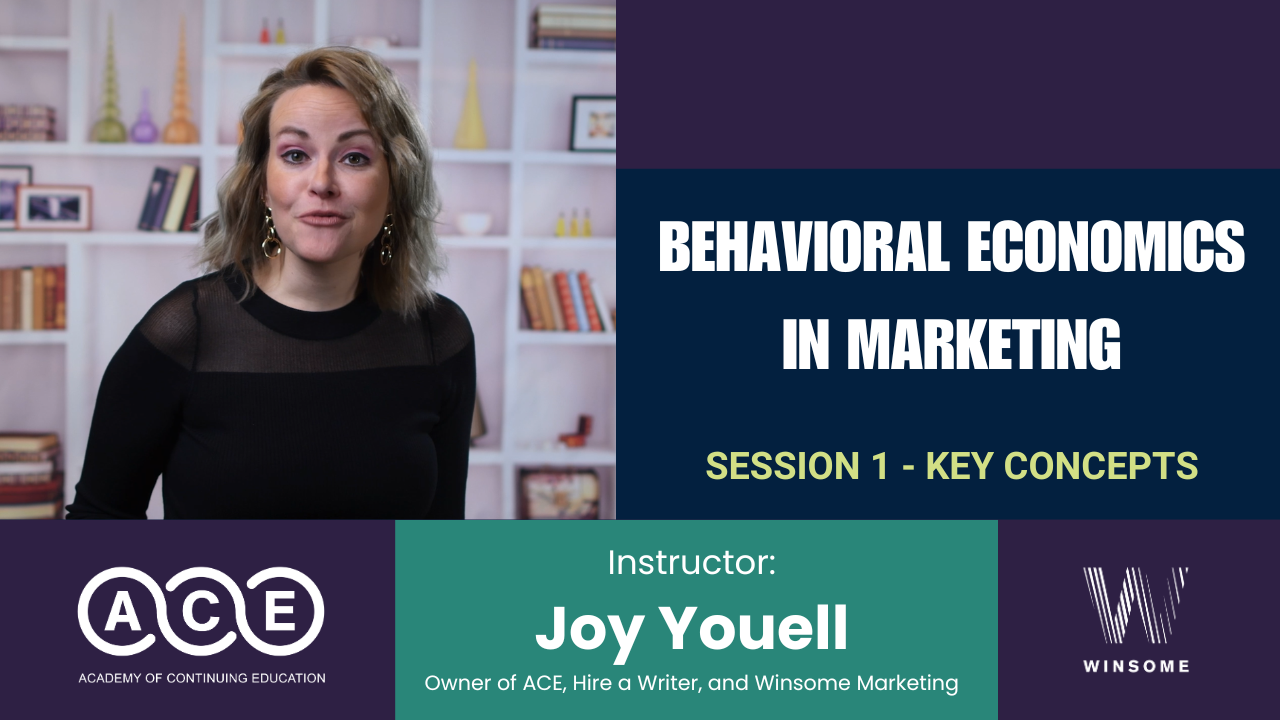Behavioral Economics: The Science Behind Effective Marketing
Traditional marketing approaches often assume consumers make purely rational, self-interested choices—but the reality is far more complex. Enter...
6 min read
 Joy Youell
:
Mar 18, 2025 10:08:38 AM
Joy Youell
:
Mar 18, 2025 10:08:38 AM

Consumers make hundreds of decisions daily, from routine purchases to complex investments. But how do they navigate this constant decision-making without experiencing complete mental exhaustion? The answer lies in heuristics—mental shortcuts that allow the human brain to process information and make judgments quickly and efficiently.
For marketers, understanding these cognitive shortcuts is more than academic curiosity—it's the key to creating strategies that align with how consumers actually make decisions. Let's explore the fascinating world of heuristics and biases and discover how savvy marketers can ethically leverage these psychological principles.
Heuristics are essentially "rules of thumb" that our brains employ to simplify decision-making. Rather than analyzing every bit of available information (which would be cognitively exhausting), we rely on these mental shortcuts to reach conclusions rapidly.
While heuristics serve a valuable evolutionary purpose—allowing us to make quick judgments in complex situations—they can also lead to systematic errors called cognitive biases. These predictable deviations from rational judgment occur when our mental shortcuts miss important details or apply inappropriate rules to specific situations.
For marketers, understanding these decision-making patterns offers profound insights. Rather than fighting against how consumers naturally process information, effective marketing works with these cognitive tendencies to create more intuitive, persuasive campaigns.
While psychologists have identified dozens of heuristics, three in particular have outsized impact on consumer decision-making:
The availability heuristic leads us to judge probability or frequency based on how easily examples come to mind. Events that are vivid, recent, or emotionally charged feel more common than statistics might suggest.
Real-World Impact: People often overestimate the likelihood of dramatic but rare events (plane crashes, shark attacks) while underestimating common but less newsworthy risks (heart disease, car accidents).
Marketing Application: BlendTec's viral "Will It Blend?" campaign brilliantly leveraged the availability heuristic. By showing their blenders pulverizing iPhones, golf balls, and other unexpected items, they created memorable, striking images that made the product's power immediately "available" in consumers' minds. When shoppers later considered blender options, BlendTec's vivid demonstrations came readily to mind, creating a perception of superiority.
Implementation Strategy: Create striking, memorable demonstrations of your product's key benefits rather than simply stating features. The more vivid and unexpected the imagery, the more "available" it becomes in consumer memory.
The representativeness heuristic leads us to categorize things based on how well they match our mental prototypes. We instinctively judge how closely something resembles our mental stereotype of a category and assume it shares other characteristics of that category.
Real-World Impact: We might assume someone wearing a lab coat is intelligent or that an expensive-looking product is higher quality, even without additional evidence.
Marketing Application: Gillette masterfully applied this principle in their "The Best A Man Can Get" campaign, which presented idealized imagery of masculinity that many men aspire to embody. By associating their razors with this representation of the "ideal man," Gillette positioned their products as the quintessential men's grooming tool—the razor a "real man" would choose.
Implementation Strategy: Identify the positive stereotypes or ideals associated with your product category, then design packaging, advertising, and brand imagery that align with these mental models.
The anchoring heuristic causes us to rely heavily on the first piece of information we encounter when making decisions. This initial "anchor" becomes the reference point against which we evaluate subsequent information, even when the anchor is completely arbitrary.
Real-World Impact: In negotiations, the first number mentioned strongly influences the final settlement, regardless of whether that initial figure was reasonable.
Marketing Application: Apple has perfected the strategic use of anchoring in their product launches. By introducing their premium models at extremely high price points first, they establish an anchor that makes their mid-tier products seem relatively affordable by comparison—even though these "more affordable" options are still premium-priced relative to competitors.
Implementation Strategy: Strategically sequence information presentation, introducing higher price points or premium options before more affordable alternatives to create favorable comparison points.
While availability, representativeness, and anchoring have outsized influence, several other heuristics significantly impact consumer behavior:
We often make judgments based on instantaneous emotional reactions rather than deliberate analysis. Our immediate feelings—positive or negative—serve as mental shortcuts for complex evaluations.
Marketing Application: Insurance companies frequently leverage the affect heuristic by evoking feelings of vulnerability and concern for loved ones, then positioning their products as solutions that provide peace of mind.
We instinctively value what seems rare, limited, or difficult to obtain. Perceived scarcity increases desirability and perceived value.
Marketing Application: Limited-time offers, exclusive releases, and "while supplies last" messaging trigger this heuristic, creating urgency and heightening perceived value.
We look to others' behavior for guidance, especially in ambiguous situations. If many people are doing something, we assume it must be correct or desirable.
Marketing Application: Highlighting customer reviews, user counts, testimonials, and "bestseller" status leverages this tendency to follow perceived group wisdom.
Beyond specific heuristics, the way choices are presented dramatically influences decisions. This falls under the umbrella of "choice architecture"—the careful design of the environments in which people make decisions.
Prospect Theory, developed by Nobel Prize winners Daniel Kahneman and Amos Tversky, demonstrates that people respond differently to information presented as gains versus losses. We're typically more motivated to avoid losses than to acquire equivalent gains.
Marketing Application: Procter & Gamble leveraged loss aversion in their Tide Pods launch, framing the product as a replacement that would make traditional detergent obsolete. Rather than simply highlighting benefits, they emphasized what consumers would miss by not switching—a more motivating approach given our heightened sensitivity to potential losses.
Adding a third, less attractive option can significantly influence preferences between two existing options, even when nobody chooses the new alternative.
Marketing Application: Software companies often offer three subscription tiers: basic, standard, and premium. The premium option often serves as a decoy that makes the standard option seem like an excellent value, even if very few customers actually select the premium tier.
The physical environment in which choices are presented shapes decisions independently of the options' actual attributes.
Marketing Application: Research shows that healthier food options are more frequently chosen when prominently displayed at eye level in cafeterias. Online, placing preferred options in prominent positions or as defaults similarly influences selection rates.
Knowledge of heuristics and biases gives marketers significant power to influence behavior. With this power comes important ethical responsibilities:
There's a spectrum between ethical influence and manipulation:
To stay on the ethical side of the continuum:
Here are concrete ways to ethically leverage understanding of cognitive shortcuts:
When implementing heuristic-based strategies, look beyond immediate conversion rates to measure true effectiveness:
The most successful heuristic-based strategies create win-win outcomes, where influenced choices lead to genuinely satisfied customers who become long-term advocates.
Understanding heuristics and biases represents a fundamental shift in marketing philosophy—from trying to persuade the rational mind to working with the natural cognitive processes that actually drive decisions.
The most effective modern marketing doesn't fight the current of human psychology but flows with it, creating experiences that feel intuitive rather than demanding, natural rather than forced. By respectfully leveraging these insights, marketers can create more engaging, effective campaigns while building lasting trust with consumers.
As we continue to learn more about the fascinating shortcuts our minds use to navigate complexity, the opportunity to create more human-centered, psychologically-informed marketing grows—benefiting both businesses and the consumers they serve.
Ready to transform your marketing with proven psychological insights? Join ACE from Winsome today for exclusive access to cutting-edge content on consumer psychology, behavioral economics, and practical frameworks for applying these principles ethically and effectively. Our community of forward-thinking marketers is revolutionizing how brands connect with customers through deeper psychological understanding. Sign up now and start creating marketing that works with—not against—how your customers naturally make decisions!

Traditional marketing approaches often assume consumers make purely rational, self-interested choices—but the reality is far more complex. Enter...
-1.png)
When two people fall into conversational rhythm—finishing each other's sentences, mirroring posture, matching speaking pace—they've entered a state...
-2.png)
We've built commerce on the promise of infinite choice, yet our brains—those same neural networks that once had to choose between fight and...